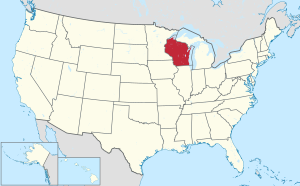|
Buffalo County, Wisconsin
Buffalo County is a county located in the U.S. state of Wisconsin. As of the 2020 census, the population was 13,317.[1] Its county seat is Alma.[2] The county was created in 1853 and organized the following year.[3][4] HistoryBuffalo County, founded in 1853, is named for the Buffalo River, which flows from Strum to Alma, where it empties into the Mississippi River. The Buffalo River obtained its name from the French voyager Father Louis Hennepin, who named it Riviere des Boeufs in 1680. The first permanent settlement was established in 1839, located in what is now Fountain City. This settlement was originally named Holmes' Landing after a family who traded with the Sioux and Chippewa. Buffalo County was settled primarily by Swiss, German, and Norwegian immigrants who were drawn to the area by the growing lumber industry, fertile soils, access to the Mississippi, and available land. By 1848, a second community was established called Twelve Mile Bluff, which is now known as Alma.  Agriculture developed during the 1850s on top of the ridges where natural prairies and oak savannas occurred, which made working the land much easier. With the lack of good roads, settlement remained along the Mississippi River, where farmers could ship their grain on steamboats. The development of the Northern Rail from Winona, Minnesota, allowed for development away from the river, and by 1890, farmers were transporting their goods predominantly by rail. The Civil War gave a boost to the local economy with the rising demand for wheat, which was the main crop of the county. The postwar period brought a large influx of settlers; however, because of declining soil fertility, many moved west rather than adopt crop rotation and fertilization.[citation needed] With the price of wheat falling, farmers turned to dairy farming, and by the 1880s, local creameries had started to appear. GeographyAccording to the U.S. Census Bureau, the county has a total area of 710 square miles (1,800 km2), of which 672 square miles (1,740 km2) are land and 38 square miles (98 km2) (5.3%) are covered by water.[5] Adjacent counties
Major highwaysRailroads
BusesDemographics
2020 censusAs of the census of 2020,[1] the population was 13,317. The population density was 19.7 people per square mile (7.6 people/km2). There were 6,506 housing units at an average density of 9.6 units per square mile (3.7 units/km2). The racial makeup of the county was 95.0% White, 0.3% Black or African American, 0.3% Native American, 0.2% Asian, 0.1% Pacific Islander, 1.1% from other races, and 3.0% from two or more races. Ethnically, the population was 2.5% Hispanic or Latino of any race. 2000 censusAs of the census[11] of 2000, there were 13,804 people, 5,511 households, and 3,780 families residing in the county. The population density was 20 people per square mile (7.7 people/km2). There were 6,098 housing units at an average density of 9 units per square mile (3.5 units/km2). The racial makeup of the county was 98.69% White, 0.12% Black or African American, 0.30% Native American, 0.33% Asian, 0.02% Pacific Islander, 0.08% from other races, and 0.46% from two or more races. 0.62% of the population were Hispanic or Latino of any race. 44.3% were of German, 22.1% Norwegian and 8.8% Polish ancestry. 96.9% spoke English, 1.6% Spanish and 1.1% German as their first language. There were 5,511 households, out of which 30.80% had children under the age of 18 living with them, 58.90% were married couples living together, 6.20% had a female householder with no husband present, and 31.40% were non-families. 27.10% of all households were made up of individuals, and 12.60% had someone living alone who was 65 years of age or older. The average household size was 2.47 and the average family size was 3.01. In the county, the population was spread out, with 25.10% under the age of 18, 6.90% from 18 to 24, 27.60% from 25 to 44, 23.70% from 45 to 64, and 16.80% who were 65 years of age or older. The median age was 39 years. For every 100 females there were 100.70 males. For every 100 females age 18 and over, there were 101.40 males. In 2017, there were 121 births, giving a general fertility rate of 58.4 births per 1000 women aged 15–44, the 22nd lowest rate out of all 72 Wisconsin counties. 33 of the births were to unmarried mothers, 88 to married mothers.[12] Additionally, there were fewer than five reported induced abortions performed on women of Buffalo County residence in 2017.[13] CommunitiesCities
VillagesTownsCensus-designated placesOther unincorporated communitiesRailroad junctionsGhost towns/neighborhoodsPolitics
Between 1948 and 1984, Buffalo County voted for the nationwide winner in every election with the exception of the very close 1960 election. Then, from 1988 to 2012, like most of the rural counties in southwestern Wisconsin, it backed the Democratic candidate in each election, and did so by more than a 6% margin each time except for 2000 and 2012, which were both decided by less than a 3% margin. The results from 2012 foreshadowed the shift in the electorate in Buffalo County, as in 2016, once again like the rest of rural southwestern Wisconsin, the county dramatically swung to the right, shifting 25 points and giving a 22% victory to Republican Donald Trump. Trump further expanded his margin of victory to over 25% in 2020 and to over 30% in 2024, achieving the two highest vote shares for a Republican in the county since Dwight D. Eisenhower in his 1952 landslide victory. Notable people
See also
References
Further reading
External links
|
|||||||||||||||||||||||||||||||||||||||||||||||||||||||||||||||||||||||||||||||||||||||||||||||||||||||||||||||||||||||||||||||||||||||||||||||||||||||||||||||||||||||||||||||||||||||||||||||||||||||||||||||||||||||||||||||||||||||||||||||||||||||||||||||||||||||||||||||||||||||||||||||||||||||||||||||||||||||||||||||||||||||||||||||||||||||||||||||||||||||||||||||||||||||||||




